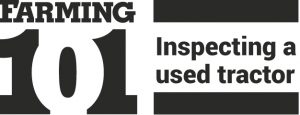You’ve been scouring the classifieds and auction sections of the Farm and Dairy and you think you’ve found a good deal on a tractor. It’s time to take a closer look.
Jason Hartschuh, ag and natural resources extension agent in Crawford County, Ohio, offered these tips for inspecting a used tractor during a talk at the 2017 Farm Science Review.

1Visual
Shiny paint looks nice but can also hide the tractor’s history. Take a closer look. Lots of dents could mean the previous owner did not take care of the tractor. Check for wear on the drawbar and three-point hitch and check controls for linkage wear. Inspect the frame and axles for any signs of repair welds.
Look for caked dirt around fittings or joints, which could be a sign of a leak, and check the front and rear engine transmission seals. If filters look old, it may be a sign of how long the tractor has been sitting. Check the oil level and quality on the dipstick; look for any creaminess or signs of water in the oil.
2Start it up
Once the tractor fires up, check for blue, white or continuous black smoke. The smoke should clear quickly unless the tractor is under load. Listen for any taps in the engine. Open the radiator to look for bubbles; open the engine fill port to observe for gases, and check for film in the oil fill port. Check all other fluids and look for foam or gases.
3Test drive
You’ll need to take the tractor for a short drive to test the brakes, gears and steering. Stand on the brakes to check for clutch slippage. Check each gear for slippage or gear chatter. Check the steering for wear and make sure tires are going the right direction.
Cycle each hydraulic remote for leaks and test the PTO system. Turn on all lights and inspect them. If the tractor has heat and air conditioning, test both to make sure they are working properly — air conditioning is often a problem and expensive.
4The home inspection
Once you’ve decided to make the purchase, it doesn’t hurt to do a more thorough inspection. Change all fluids and filters, and grease all fittings and bearings. Remove the oil pan, feel the cylinder, check rod bearings and check the pan for metal flakes or sludge. Open the transmission inspection cover, inspect gears, look for chips and feel around. Conduct a pressure test on the hydraulics system.
Source: Selecting a new or used tractor for a small farm, Jason Hartschuh, Farm Science Review, Small Farms Center.
Next week: Final considerations for purchasing new or used tractors.
(Farm and Dairy is featuring a series of “101” columns throughout the year to help young and beginning farmers master farm living. From finances to management to machinery repair and animal care, farmers do it all.)
More Farming 101 columns:
- How to buy the right tractor for your farm
- 5 tips for a better farm marketing plan
- How to seek help with retirement planning
- How to set goals for retirement
- A farmer’s guide to saving for retirement
- A farmer’s guide to planning for retirement
- 5 steps to get NRCS assistance
- How can conservation easements help you?
- How to fund conservation plans
- What is a conservation plan?
- How can NRCS help you?
- More airborne hazards on the farm
- 5 airborne hazards to beware of on the farm
- 5 things to know about Wagyu beef
- Pennsylvania utility vehicle laws
- Ohio utility vehicle laws
- Farm chemical safety checklist
- When should a farm become a business entity?
- Harvest prep: Check your yield monitors
- How to tag livestock properly
- 6 tips for decision making on a family farm
- 8 tips to prepare your farm for agritourism
- How to plan for farm emergencies
- 7 keys to success on the farm
- 7 tips for healthy fair animals
- 5 tips to ensure livestock health before the fair
- 6 tips to keep your livestock parasite free
- 6 tips for vaccinating your livestock
- 5 tips to prevent dairy cow foot problems
- 6 common foot problems found in dairy cows
- Recognize, prevent heat stress in dairy cattle
- How to monitor your dairy herd
- How to start your own dairy farm
- 5 tips for sun safety in the field
- Employing youth for the summer
- What to do if a hay fire occurs
- How to prevent hay fires
- How to extend the life of your fence
- 10 safety tips for installing electric fences
- How to chose the right fence for your farm
- How to create a fencing plan
- 7 steps for easy sprayer calibration
- Prepare for planting season, Part 2: Calibration
- Prepare for planting season, Part 1: The Basics
- 7 tips to improve security on your farm
- 5 tips to protect your farmland
- 3 measures to deal with severe farm debt
- How to buy time to catch up on farm debt
- 6 tips to manage income on the farm
- 5 tips to recognize and deal with farm stress
- How to prepare a livestock birthing kit
- 5 tips for marketing your farm
- How to develop farm mission, vision statements
- 5 tips for setting farm goals
- 2 types of livestock insurance policies
- 6 things you need to know about WFRP plans
- 3 basics of crop insurance
- How does liability insurance work on the farm?
- Why do I need farm insurance?
- How to understand and use Ohio’s CAUV
- How to utilize the Pa. Clean and Green Act
- 9 tips for filing farm taxes
- 8 reasons record keeping for taxes is essential
- 5 tips for post-harvest storage
- 7 tips for family meetings on the farm
- 4 tips for balancing your farm and family
- 4 tips for communicating on the family farm
- 4 tips for firing an employee
- 6 tips for keeping good farm help
- 4 tips for recruiting farm labor
- 5 general farm labor laws
- 4 tips for employing minors
- 4 tips for PTO safety
- 5 things young farmers should know about finances
- The farm balance sheet
- 5 items for your farm’s cash flow statement
- Personal and business records: Keep them separate
- What to include in your farm business plan
- How to approach a lender: Tips for getting a farm loan
- How to use microloans to get your farm started
- Saving for the future: 6 tips for young farmers
- How to create a farm safety kit
- 5 tips for child safety on the farm
- 4 tips for transporting livestock
- 5 ways to better understand tractor stability
- 6 farm equipment hacks












